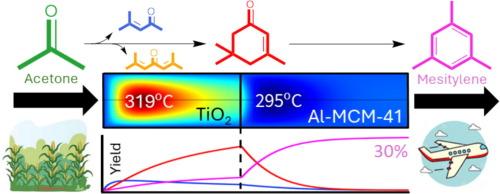Modelling and optimization of a multifunctional catalytic fixed-bed reactor for acetone self-condensation to mesitylene
IF 13.2
1区 工程技术
Q1 ENGINEERING, CHEMICAL
引用次数: 0
Abstract
A mathematical model able to simulate the behavior of multifunctional one-pot catalytic fixed-bed reactors has been developed in this article. Acetone self-condensation-dehydration to mesitylene was selected as model reaction that requires the simultaneous presence of basic and acid catalysts.The model is based on momentum, mass and energy conservation equations solved on a 2D axisymmetric coordinate system of the fixed bed. This model was validated with experiments carried out in a bench-scale reactor using commercial size pellets of TiO2 and Al-MCM-41 catalysts. The simulations were used to optimize the operating conditions and scale-up the multifunctional one-pot catalytic reactor. The optimization was done by means of a sensitivity analysis of the key reactor variables: temperature, pressure, space velocity, and catalyst fraction. The best performance (64% acetone conversion and 30.7% mesitylene yield) was achieved using a double-bed reactor configuration, formed by a first bed of TiO2 followed by a second bed of Al-MCM-41.The proposed approach enables the optimization of jet-fuel additives production from renewable sources based on acetone. The developed model and insights from this study provide a foundation for further optimization and commercialization of the process, contributing to the development of sustainable chemical processes in the aviation sector.

丙酮自缩合制甲三甲苯多功能催化固定床反应器的建模与优化
本文建立了一个能够模拟多功能一锅固定床催化反应器行为的数学模型。选择丙酮自缩合脱水制三甲苯为模型反应,该反应需要碱性和酸性催化剂同时存在。该模型基于在固定床的二维轴对称坐标系上求解的动量、质量和能量守恒方程。该模型在一个实验规模的反应器中进行了验证,实验使用了工业尺寸的TiO2颗粒和Al-MCM-41催化剂。利用模拟结果对多功能一釜催化反应器的操作条件进行了优化和放大。优化是通过对关键反应器变量:温度、压力、空速和催化剂分数的敏感性分析来完成的。采用第一层TiO2和第二层Al-MCM-41组成的双层反应器结构,获得了最佳的丙酮转化率(64%)和三甲苯产率(30.7%)。提出的方法能够优化基于丙酮的可再生燃料的喷气燃料添加剂生产。本研究开发的模型和见解为该过程的进一步优化和商业化奠定了基础,有助于航空领域可持续化学过程的发展。
本文章由计算机程序翻译,如有差异,请以英文原文为准。
求助全文
约1分钟内获得全文
求助全文
来源期刊

Chemical Engineering Journal
工程技术-工程:化工
CiteScore
21.70
自引率
9.30%
发文量
6781
审稿时长
2.4 months
期刊介绍:
The Chemical Engineering Journal is an international research journal that invites contributions of original and novel fundamental research. It aims to provide an international platform for presenting original fundamental research, interpretative reviews, and discussions on new developments in chemical engineering. The journal welcomes papers that describe novel theory and its practical application, as well as those that demonstrate the transfer of techniques from other disciplines. It also welcomes reports on carefully conducted experimental work that is soundly interpreted. The main focus of the journal is on original and rigorous research results that have broad significance. The Catalysis section within the Chemical Engineering Journal focuses specifically on Experimental and Theoretical studies in the fields of heterogeneous catalysis, molecular catalysis, and biocatalysis. These studies have industrial impact on various sectors such as chemicals, energy, materials, foods, healthcare, and environmental protection.
 求助内容:
求助内容: 应助结果提醒方式:
应助结果提醒方式:


